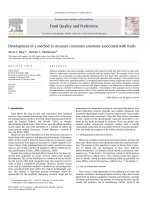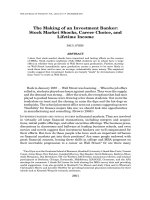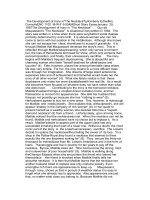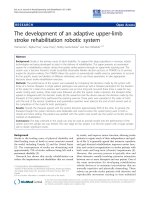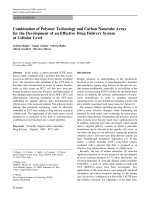the development of an instrument to measure individual dispositions towards rules and principles; with implications for financial regulation
Bạn đang xem bản rút gọn của tài liệu. Xem và tải ngay bản đầy đủ của tài liệu tại đây (4.68 MB, 379 trang )
Glasgow Theses Service
Feng, Ying (Olivia) (2014) The development of an instrument to measure
individual dispositions towards rules and principles; with implications for
financial regulation. PhD thesis.
Copyright and moral rights for this thesis are retained by the author
A copy can be downloaded for personal non-commercial research or
study, without prior permission or charge
This thesis cannot be reproduced or quoted extensively from without first
obtaining permission in writing from the Author
The content must not be changed in any way or sold commercially in any
format or medium without the formal permission of the Author
When referring to this work, full bibliographic details including the
author, title, awarding institution and date of the thesis must be given.
1
1
The development of an instrument to measure
individual dispositions towards rules and principles;
with implications for financial regulation
Ying (Olivia) Feng
BAL, MRes, Enterprise Fellow of the Royal Society of Edinburgh
Thesis Submitted in Fulfilment of the Requirements for the Degree of
Doctor of Philosophy (PhD)
Adam Smith Business School
College of Social Sciences
University of Glasgow
September 2013
2
2
Acknowledgements
I would like to first of all express my deep gratitude towards my loving parents, Mrs
Ding De Zhen and Mr Feng Shu Lin who supported me through what has
undoubtedly been the most challenging task I have undertaken in my life so far. I
know I always have my parents to count on when times are tough.
I would also like to thank my friends in Glasgow for being understanding and offering
help whenever I needed it in all sorts of forms. In particular, I would like to thank my
dear friends Alvise Favotto and Stan Kerr (who has sadly passed away in September
2013 unexpectedly) for supporting me academically and emotionally throughout my
research journey, showing patience to my sometimes unreasonable demands. I would
like to thank Eirini Bazaki for being a wonderful friend and flatmate. I also wish to
thank Alan. S. Johnston for proofreading my thesis.
I would like to thank my two supervisors, Professor John Francis McKernan and
Professor Patrick J. O’Donnell for their continuous support. I feel eternally grateful to
you both. Without your encouragement and guidance; the completion of this PhD
would not have been possible.
I would like to thank all the people who have participated in my research. I would like
to express my gratitude to Glasgow University, Accounting and Finance department,
for funding my PhD. I also would like to express my gratitude to the Institute of
Chartered Accountants of Scotland for providing support in the form of Seed-corn
funding for some of the data collection involved in this PhD.
Finally, I would like to thank myself and God, for believing in myself and being
persistent in the face of many obstacles and challenges. The PhD journey has taught
me much more than just academic research, it has made me a better human being.
3
3
Abstract
The main focus of this PhD project is the development and validation of a
psychometric instrument for the measurement of individual dispositions towards rules
and principles.
Literature review and focus groups were used to generate insights into the reasons
why individuals prefer rules and principles. On the basis of that review, an initial item
pool was created covering the conceptual space of dispositions towards rules and
principles.
The final instrument consists of 10 items, 5 items each for the rules and principles
subscales. The psychometric analysis suggested that it is valid and reliable.
The instrument has sound predictive power and was able to significantly predict
individuals’ behavioral intentions in relation to rules and principles across contexts. I
found there were gender and ethnic differences in the relationship between
dispositions towards rules and principles scores and behavioural intentions.
This PhD is relevant to an emerging literature in behavioural accounting research that
examines how practitioners’ personal characteristics and styles affect financial
reporting practice.
4
4
Table of Contents
Acknowledgements 2
Abstract 3
Table of Contents 4
List of Tables 14
List of Figures 18
Author’s Declaration 20
Abbreviations 21
Chapter 1: Introduction to the PhD 22
1.1 Introduction 22
1.1.1 The objective of the present PhD 22
1.1.1.1 My prior research journey 22
1.2 The organisation of the chapter 23
1.3 Rules vs. principles after the Global Financial Crisis 24
1.3.1 Research Background 25
1.3.2 Research Gap 26
1.4 Research Motivation 28
1.5 Research Questions 30
1.6 Research design and methods 36
1.7 Definitions of rules and principles as based on legal regulatory discussions 37
1.8 Chronology of the thesis 38
1.9 The intended contributions of this research 41
1.10 Conclusion 43
Chapter 2: Methodology and Methods 45
2.1 Objective for chapter and overview of content 45
2.2 Overall steps taken in this project 45
5
5
2.2.1 Conducting literature review for the generation of initial item pool 47
2.2.2 Steps adopted in this project 47
2.3 Basic methodological assumptions underlying the research 49
2.4 Methodology: Mixed method 51
2.5 Main research method: survey 51
2.5.1 Demonstrating the validity and reliability of the instrument 52
2.5.2 The main research method: Survey 54
2.5.2.1 The strengths of survey 54
2.5.2.2 The weakness of survey and potential remedies 54
2.6 Conclusion 55
Chapter 3: Rules vs. Principles in Accounting 56
3.1 Introduction 56
3.1.1 The organisation of the chapter 57
3.2 Trust and the debate 57
3.3 Definitions of rules- and principles-based regulation 58
3.3.1 The characteristics of a rules-based and a principles-based standard 60
3.3.1.1 Principles increase judgment and accountability 60
3.3.2 Institutional and political contexts of the rules vs. principles debate 61
3.4 Overview of the dimensions 62
3.4.1 Need for security 62
3.4.2 Need to ensure uniformity vs. flexibility 64
3.4.3 Need for predictability and certainty 65
3.4.4 Need for innovation 66
3.4.5 Concern for complexity 67
3.4.6 Concern for manipulation 69
3.4.7 Legitimacy issue 71
3.4.8 Concern for Ethics 71
3.4.9 Effectiveness 72
3.4.10 Efficiency 73
3.4.11 Need to reach closure 74
6
6
3.4.12 Abstractness vs. concreteness 74
3.4.13 Need for procedural fairness 75
3.5 Conclusion 75
Chapter 4: Rules and Principles in Law 77
4.1 Introduction 77
4.1.1 Overview of the chapter 78
4.2 Formalism vs. Anti-Formalism 78
4.2.1 The problems with the formalism 80
4.2.2 Anti-Formalism 81
4.3 Justification of choosing Dworkin’s positions 81
4.3.1 Dworkin: A Philosophical Basis 82
4.3.2 Legal Positivism on rules 83
4.3.3 Dworkin’s attacks on Positivism 84
4.4 Dworkin’s position on rules and principles 85
4.4.1 Two distinctions between a rule and a principle 86
4.4.1.1 Recognition conditions: validity 86
4.4.1.2 Application Conditions: relevance 88
4.4.2 Rules and Principles interplay 89
4.5 Criticisms of Dworkin’s rules vs. principles 90
4.6 Distinguishing principles and rules from other concepts 91
4.6.1 Analogies vs. rules and principles 91
4.6.2 Heuristics vs. rules 93
4.6.3 Rights, policies vs. rules and principles 93
4.7 Conclusion 94
Chapter 5: Psychological roots of rules and principles 96
5.1 Introduction 96
5.1.1 Organisation of the chapter 97
5.2 The nature of dispositions 98
5.3 Literature review on parenting style 99
7
7
5.4 Traits vs. Values vs. Cognitive styles 102
5.4.1Values and cultural difference - DRP 104
5.4.2 Legitimacy of rules and principles being studied in this project 105
5.5 Personality Factors 106
5.5.1 Conscientiousness 108
5.5.2 Extraversion 109
5.5.3 Openness to experience 109
5.6 Overview of constructs positively related to principles-orientation 110
5.6.1 Locus of control 110
5.6.2 Empowerment and self-efficacy 111
5.7 Overview of cognitive styles 112
5.7.1 Cognitive style - Need for Closure 112
5.7.2 Cognitive Thinking style 114
5.7.3 Higgins regulatory focus and the DRP 117
5.8 Conclusion 118
Chapter 6: Focus groups 120
6.1 Introduction 120
6.1.1 Overview 120
6.2 The focus groups 121
6.2.1 The nature and aims of focus groups 121
6.2.2 The abstract questions probing approach in focus groups 121
6.3 The practicalities of conducting focus groups 122
6.3.1 Recruiting participants and organising each focus group 122
6.3.2 Managing attendance 122
6.3.3 The size and number of the groups 123
6.3.4 Data privacy and anonymity 123
6.3.5 The role of Moderator and observer 123
6.4 The actual operationlisation of the focus groups 124
6.4.1The descriptive summary of the participants for 4 focus groups 124
6.4.2 The general questions which have been covered by the focus groups: 125
8
8
6.5 Transcribing Focus Group data 126
6.5.1 Data Analysis 126
6.6 Discussions: results of the preliminary study 127
6.6.1 Key words 134
6.6.2 Summary of the analysis of the focus groups 135
6.7 Conclusion 136
Chapter 7: Framework of the dimensions underpinning disposition towards rules and
principles 137
7.1 Introduction 137
7.1.1 Overview 138
7.2 Overview of the 14 dimensions 138
7.2.1 The ethical dimension 138
7.2.2 The legitimacy dimension 140
7.2.3 Procedural Fairness 142
7.2.4 Concreteness vs. abstractness 143
7.2.5 Uniformity versus Flexibility 144
7.2.6 Need for certainty and predictability 145
7.2.7 Complexity 146
7.2.8 Need for security 147
7.2.9 Need for closure 149
7.2.10 Efficiency 150
7.2.11 Creativity 152
7.2.12 Empowerment 152
7.2.13 Effectiveness 154
7.2.14 Manipulation 154
7.3 The possible inter-relationships 156
7.4 Conclusion 159
Chapter 8: Initial item pool testing and reduction 160
8.1 Introduction 160
8.1.1 Overview 160
9
9
8.2 Preliminary item pool 160
8.2.1 Generating a pool of preliminary items 161
8.2.2 The scaling method: Likert scale 161
8.2.3 Self checking criteria for item Generation 161
8.2.4 Rationale for the multiple-items approach 162
8.3 Piloting stage one: 163
8.3.1 Qualitative piloting: Peer review panels 163
8.3.1.1 Ethical approval 163
8.3.1.2 Participants for the peer review sessions 164
8.3.1.3 The descriptive data of the sample 164
8.3.1.4 Analysing the feedback 165
8.3.2 Qualitative piloting: the subject matter experts 166
8.3.2.1 Problems identified by the experts and subsequent steps taken 167
8.3.3. The outcome after qualitative review stage of piloting 168
8.4 Online survey 169
8.4.1 Ethical Approval and Privacy Note 169
8.4.2 Sample recruitment for the online survey 170
8.4.3 Demographic data analysis of the preliminary item pool 170
8.4.4 Limitations of online survey and our remedy 171
8.4.5 Testing people’s ability in distinguishing between rules and principles 171
8.5 Piloting: quantitative analysis 174
8.5.1 Sample size 174
8.5.2 On using students as research subjects 175
8.5.3 Normality distribution 175
8.5.4 Missing data 176
8.5.5 Internal consistency reliability 176
8.5.5.1 Reversed items 178
8.5.5.2 Ways to improve the Cronbach’s alpha 178
8.5.6 Cronbach’s alpha analysis for 28 subscales 178
8.6 Exploratory Factor analysis (EFA) 181
8.6.1 Factor loading and factor scores 183
8.6.1.1 The choice of rotation 183
10
10
8.6.1.2 Checking for multicollinearity 184
8.6.1.3 Criteria for factor extraction and item removal 184
8.6.2 Initial principles component analysis on the 160 items 184
8.6.3 Rules and principles subscale (15 items) 188
8.6.3.1 Reliability of the rules and principles subscale (15 items) 190
8.6.4 An ad hoc analysis on the remaining items (resulting 13 items) 192
8.7 Conclusion 194
Chapter 9 Part one: Further refinement of the instrument 196
9.1 Introduction 196
9.1.1 The overview of the chapter 196
9.2 Preparation for the empirical study: some preliminary considerations 196
9.2.1 Objective of the current EFA 196
9.2.2 Sample size for factor analysis for confirmatory purpose 197
9.2.3 Sample recruitment 197
9.2.4 Monetary incentive and ICAS seed funding 198
9.3 Exploring the data 198
9.3.2 Respondents’ profile 199
9.4 Confirmatory analysis of DRP scales 200
9.4.1 Interpretation of the factors 202
9.5 Evidence supporting the reliability of the DRP 203
9.5.1 Internal consistency reliability 203
9.5.2 Test re-test Reliability 204
9.6 Relationships between rules and principles subscale (response to RQ2) 205
9.7 Demographic variables analysis 205
9.7.1 Gender factor scores analysis 206
9.7.2 Ethnic group analysis 206
9.7.3 Age analysis 207
9.8 Summary and conclusion of part one 208
Chapter 9 Part two: Convergent and Divergent validity of DRP 209
11
11
9.9 Overview 209
9.10 The justification of use shorter version of scales 209
9.11 Evidence supporting the validity of DRP 210
9.11.1 Divergent validity of DRP 211
9.11.1.1 DRP and Higgins RFQ 211
9.11.1.2 DRP and the socially desirability test 212
9.11.1.3 DRP and the DSS 212
9.11.2 Convergent validity of DRP 213
9.11.2.1 DRP and the Ten Item Personality Inventory TIPI 213
9.11.2.2 DRP and Need for closure 214
9.11.2.3 DRP and Sternberg’s thinking style 216
9.12 Summary of the convergent and divergent validity of the DRP 219
9.12.1 Convergent validity of the DRP 219
9.12.2 Divergent validity 220
9.12.3 Interpretation of the overall result 220
9.13 Discussion and Summary of the validity test results 222
Chapter 9 Part three: Predictive validity of the DRP 223
9.14 Predictive validity 223
9.14.1 Attitudes, behavioural intention and behaviour 223
9.14.2 A summary of eight scenarios 224
9.15 Part one: DRP and BI (correlation analysis and multiple regression) 226
9.15.1 The correlation analysis 226
9.15.2 Part two: The Multiple Regression analysis 228
9.15.2.1 Analysis for the professional scenarios 228
9.15.2.2 Analysis for the private life scenarios 231
9.15.2.3 Overall result and summary 233
9.16 Using DRP rules and principals scores as predictors 234
9.16.1 Two categories of scenario scores 234
9.16.4.1.1 Professional scenario analysis 235
9.16.4.1.2 Personal scenario analysis 237
9.16.4.1.3 Overall result and discussion 238
12
12
9.16.2 Four categories of scenario scores 238
9.16.4.2.1 Professional context scenarios analysis 239
9.16.4.2.2 Personal context scenarios analysis 246
9.16.4.2.3 Overall result and discussion 249
9.17 Four categories of DRP scores 249
9.17.1 Overall result and discussion 252
9.18 Scenario context analysis 253
9.19 Demographic variable analysis 253
9.19.1Checking the gender neutrality of the scenarios 253
9.19.2 A summary of the regression model of demographic variables 254
9.19.3 Gender analysis in relation to contexts 254
9.19.4 Ethnicity differences analysis 260
9.19.5 Summary: demographic variables in relation to context 265
9.20 Conclusion and summary of chapter nine 265
Chapter 10: Conclusion and future thoughts 267
10.1 Overview 267
10.2 Summary of the findings 267
10.3 Critical assessment of the methods applied 272
10.3.1 A positivist stance 272
10.3.2 Using hypothetical scenarios to proxy BI 273
10.3.3 Using test-retest in validating reliability 275
10.3.4 The sample and sampling method 276
10.4 Contribution 277
10.4.1 Contribution to the theory 277
10.4.2 The potential value of the DRP in behavioural accounting research 278
10.4.3 Understanding accountants psychological profile 278
10.4.4 Contributing to the gender and ethnicity studies in accounting 280
10.5 The implications 281
10.5.1 Implication of DRP in Accounting research 281
10.5.2 Implication of DRP in recruitment and HR 281
13
13
10.5.3 Implication of DRP in policy-making 283
10.6 Future work 284
10.6.1 Scale structure 284
10.6.2 Examine the ‘fit & misfit’ effect 284
10.6.3 Examine the ‘priming effect’ 286
10.6.4 Examine the moderating variables 286
10.6.5 Using DRP in conjunction with verbal protocols 286
10.7 Conclusion 287
Appendices 288
Appendix 1 – Preliminary item pool (323 items) with respective source 288
Appendix 2- Introductory message for the online survey 311
Appendix 3- Descriptive Statistics for 323 items (including miss data analysis) 313
Appendix 4-Covering letter for the sample recruitment (preliminary items pool) 320
Appendix 5-Cronbach’s alphas for 28 dimensional scales 321
Appendix 6-Eight scenarios 333
Appendix 7-Other Psychometric scales were used in this project 338
Ten-Item Personality Inventory-(TIPI) 338
The Marlowe-Crowne Social Desirability Scale (MCSDS) 339
Thinking Styles Inventory—Revised II (TSI-R2) 340
Dialectical Self Scale (DSS) 344
Need for Closure Scale 346
Higgins RFQ 348
References 350
14
14
List of Tables
Table 1 A summary of the sample size for each step of empirical work 49
Table 2 The characteristics of rules- and principles-based standards 60
Table 3 Two distinctions between rules and principles as identified by Dworkin 86
Table 4 The Big5 personality traits 107
Table 5 Dimensions of the thinking style 114
Table 6 The overview of the demographic data of the sample for focus groups 125
Table 7 Key words patterns associated with expressions of rules and principles
respectively 134
Table 8 Self-checking criteria for the initial preliminary item pool 162
Table 9 Demographic data for the peer review participants 164
Table 10 Demographic data of the experts 167
Table 11 Demographic statistics of respondents for the online preliminary item pool
171
Table 12 A test on whether individuals can distinguish between rules and principles
172
Table 13 Extremely skewed items 176
Table 14 Internal reliability of rules scales in the reaching closure dimension 178
Table 15 Internal reliability of principles scales in the reaching closure dimension . 179
Table 16 items being omitted due to the negative inter-item correlations 179
Table 17 A summary of the Cronbach’s alpha for all 14 dimensional subscales 180
15
15
Table 18 The factor loading (Factor structure coefficients) of the DRP preliminary
study 188
Table 19 Reliability of the principle subscale 190
Table 20 Reliability of the rules subscale 191
Table 21 Factor loadings of the ad hoc analysis of the minor factors 193
Table 22 Descriptive statistics of the 15 items from previous factor solution (n=474)
199
Table 23 Gender of the respondents 199
Table 24 Age range of the respondents 199
Table 25 Ethnic backgrounds of the respondents 200
Table 26 Factor loading of the final 10 items in DRP 201
Table 27 Reliability of the rules subscale 203
Table 28 Reliability of the principles subscale 204
Table 29 Gender statistics 206
Table 30 Ethnic groups DRP scores 206
Table 31 Three age groups DRP scores 207
Table 32 DRP and Higgins RFQ 211
Table 33 DRP and Socially desirability test 212
Table 34 DRP and DSS 212
Table 35 DRP and TIPI 213
Table 36 DRP and Need for closure 215
Table 37 DRP and Sternberg’s thinking style 217
Table 38 Correlations supporting the convergent validity of the DRP 219
16
16
Table 39 Correlations supporting the divergent validity of the DRP 220
Table 40 Psychological profile of rules-based vs. principles based individuals 220
Table 41 Summary of the eight scenarios 225
Table 42 Descriptive Statistics of the eight scenarios 226
Table 43 Summary of the rules and principles correlations with eight scenarios 227
Table 44 Multiple regression for professional scenarios 228
Table 45 Multiple regression for personal life scenarios 232
Table 46 Multiple regression for scenario average score 233
Table 47 Two categories of ANOVA for professional scenarios 235
Table 48 Two categories of ANOVA for personal life scenarios 237
Table 49 Four categories ANOVA scenario 1 239
Table 50 Four categories ANOVA scenario 3 241
Table 51 Four categories ANOVA scenario 6 242
Table 52 Four categories ANOVA scenario 7 243
Table 53 Four categories ANOVA scenario 8 245
Table 54 Four categories ANOVA scenario 2 246
Table 55 Four categories ANOVA scenario 4 247
Table 56 Four categories ANOVA scenario 5 248
Table 57 Four categories DRP scores ANOVA for professional scenarios 251
Table 58 Post Hoc analysis for 4 groups of DRP scores 251
Table 59 The Mean comparisons for rules scores between male and female 255
Table 60 The Mean comparisons for principles scores between male and female 255
17
17
Table 61 ANOVA analysis between males and females 256
Table 62 Regression model for gender and DRP 258
Table 63 The Mean comparisons for rules scores between two ethnic groups 260
Table 64 The Mean comparisons for principles scores between two ethnic groups . 261
Table 65 ANOVA analysis between two ethnic groups 261
Table 66 Regression analysis for ethnicity and DRP 264
18
18
List of Figures
Figure 1 Overview structure of the thesis 41
Figure 2 A flow chart depicting the DRP development processes 48
Figure 3 Reduction of the initial items pool via qualitative steps 168
Figure 4 Scree Plot for the initial 160 items 185
Figure 5 Scree Plot for the 69 items 186
Figure 6 Scree Plot for the remaining 22 items 186
Figure 7 Flow chart depicts the process taken to achieve the final number of items in
chapter eight 187
Figure 8 Scree Plot of the 15 items DRP 188
Figure 9 Scree Plot of the 13 items an ad hoc analysis 192
Figure 10 Scree Plot for the final 10 items 201
Figure 11 Males and females DRP scores 206
Figure 12 Ethnic groups DRP scores 207
Figure 13 Three age groups DRP scores comparison 208
Figure 14 Four categories ANOVA scenario 1 240
Figure 15 Four categories ANOVA scenario 3 241
Figure 16 Four categories ANOVA scenario 6 243
Figure 17 Four categories ANOVA scenario 7 244
Figure 18 Four categories ANOVA scenario 8 245
Figure 19 Four categories ANOVA scenario 2 247
19
19
Figure 20 Four categories ANOVA scenario 4 247
Figure 21 Four categories ANOVA scenario 5 248
Figure 22 Four groups of DRP scores 250
Figure 23 Mean plots of the four categories of DRP scores in professional scenarios
252
Figure 24 Gender choice distributions across eight scenarios 257
Figure 25 Ethnic choice distributions across eight scenarios 262
Figure 26: The fit effect: framework for experimental studies on the interactions
between rules and principles and individual judgment and decision-making 285
20
20
Author’s Declaration
Declaration of Originality
I declare that no portion of the work referred to in this thesis has been submitted in
support of an application for another degree or qualification of this or any other
university or other institute of learning.
I declare that the thesis embodies the results of my own work. Following normal
academic conventions, I have made due acknowledgements of the work of others.
Copyright Statement
Copyright of the text of this thesis rests with the author. Copies (by any process)
either in full, or of extracts, may be made only in accordance with instructions given
by the author.
Signature: ______
Printed Name: Ying Feng
21
21
Abbreviations
The Global Financial Crisis (GFC)
Dispositions towards rules and principles (DRP instrument)
Principles-based regulation (PBR)
Financial Accounting Standards Board (FASB)
Securities and Exchange Commission (SEC)
Institute of Chartered Accountants of Scotland (ICAS)
International Accounting Standards Board (IASB)
Principal components analysis (PCA)
Exploratory Factor analysis (EFA)
Special purpose entity (SPE)
Behavioural intention (BI)
Dialectical Self scale (DSS)
Regulatory Focus Questionnaire (RFQ)
California Personality inventory (CPI)
FSA (Financial Service Authority)
IFRS (International Financial Reporting Standards)
SAV (Scenarios Average Score)
TST (Twenty Statements Test)
Field Dependence/Field Independence (FD/FI)
Behavioural Accounting Research (BAR)
Judgement and Decision-Making (JDM)
22
22
Chapter 1: Introduction to the PhD
1.1 Introduction
This chapter provides an overview of the entire PhD project and reflects on the
research journey taken by the researcher. In the process, it will make clear both the
need and rationale for the study, and introduce the research design the researcher
intends to follow. This chapter is introductory and designed to give some overview of
issues.
1.1.1 The objective of the present PhD
The main focus of this PhD project is the development and validation of a
psychometric instrument for the measurement of individual dispositions towards rules
and principles. The grounding of the instrument development is inter-disciplinary, and
draws on debates concerning rules and principles in law, accounting and business,
social-psychology, and philosophy.
1.1.1.1 My prior research journey
The decision to develop such an instrument had two main inspirations. Firstly, in my
MRes research work I tried to use individuals’ ‘regulatory focus’ scores (see Higgins,
1997) to predict their behavioural responses to rules and principles-based scenarios. I
had expected that individuals’ regulatory focus orientations, as measured by Higgins’
regulatory focus questionnaire, would be a good proxy for the dispositions towards
rules and principles and capture a good deal of the variation in individuals’ responses
to rules and principles. My MRes results did not confirm the initial expectations. In
reflecting on MRes findings, I realised that various factors might plausibly be
expected to bear on individuals’ dispositions to rules and principles, and that whilst
there are various psychometric instruments that might reasonably be thought to be
relevant to the issue; there was no instrument tailor-made for the purpose of
measuring individual dispositions towards rules and principles.
23
23
Secondly, prior studies suggested that individual dispositions, in addition to directly
affecting behaviour, have an impact on, for example, preferred learning styles and the
types of learning experiences under which particular individuals perform best, and an
effect on judgment and decision-making (Ge, Matsumoto, & Zhang, 2010; Booth &
Winzar, 1993; Ramsay, Hanlon, & Smith, 2000; Fuller & Kaplan, 2004; Ho &
Rodgers, 1993). According to Ge, et al (2010, p.7), it is important to recognise the
extent of individual-specific factors, e.g., dispositions and biases, affect decision-
making (see also Hambrick, 2007). I concluded that in order to facilitate convincing
work addressing the prediction of individuals’ responses to rule- and principle-based
situations, the most useful contribution I might make, in the first instance, would be to
develop, an instrument specifically designed to reliably and validly measure
dispositions towards rules and principles.
The decision to develop a general psychological instrument in contrast to developing
a situation-specific test is based upon my conviction that basic underlying
psychological dimensions provide a sufficient basis for measuring dispositions to
rules and principles.
1.2 The organisation of the chapter
This chapter offers a brief introduction to this thesis. The remainder of this chapter is
structured as follows. Section 1.3 introduces the research context of this project.
Section 1.4 explains, in a little more detail, the important motivations driving this
research. 1.5 outlines the research questions and their theoretical justifications.
Section 1.6 introduces the chosen methodological approach and briefly explains why
it is appropriate. Section 1.7 provides some introductory discussion and explanation
of the meaning / definitions of the concepts of rules and principles as used in the
thesis. Section 1.8 outlines the chapter contents of the whole thesis. Section 1.9
identifies the main contributions of the research. Finally, section 1.10 provides a brief
conclusion to this chapter.
24
24
1.3 Rules vs. principles after the Global Financial Crisis
The Global Financial Crisis (GFC) that began around middle of 2007 and continued,
in its most intense phase, until the end of 2008 resulted in the collapse of some major
retail and investment banks, and required governments to provide massive financial
support to a banking system on the verge of total collapse
1
(Barth & Landsman,
2010). The state of regulation was certainly not solely responsible for the financial
crisis, but it is commonly recognised as having been one of the factors that in
combination with others made it possible, and the crisis has thus given rise to calls for
significant reassessment of systems of financial regulation (Black, 2010, p. 2).
The recent shift to a more rules-based regulation can be seen as a reflexive response
to the loss of trust associated with the credit crisis (Ford 2010; Black 2008; Guiso,
2010). However, Ford (2010, p.22) argues that the principles-based regulation (PBR),
as such, did not fail in the face of the GFC. She suggests that the lesson we should
take from the GFC is that regulators failed to effectively implement PBR, failed to
participate actively and sceptically in the interpreting and monitoring process
necessary to the effective implementation of the PBR, and failed to sustain good
‘regulatory conversations’ with the regulated parties (Black, 2008). She notes that the
financial markets are too fast moving and complex to be regulated in a ‘command-and
control’ manner, and that we should not risk another Enron type of scandal associated
with gaming rules (Ford, 2010). Moreover, a straight-jacketed rules-based regulation
would be more likely to create a suspicious and low-trust environment since it
reinforces the perception that “if increased regulation is justified then the people
being regulated must be suspect; guilty before proven innocent” (Swinson, 2004, cited
by Arjoon, 2006, p.68).
1
For a timeline of the crisis, New York Times, “A Year of Financial Turmoil,” (11 September 2009)
online: NYT (11 September 2009; accessed Nov 2010) online: NYT
/>IMELINE.html?ref=businessspecial4 accessed on the December 2012.
